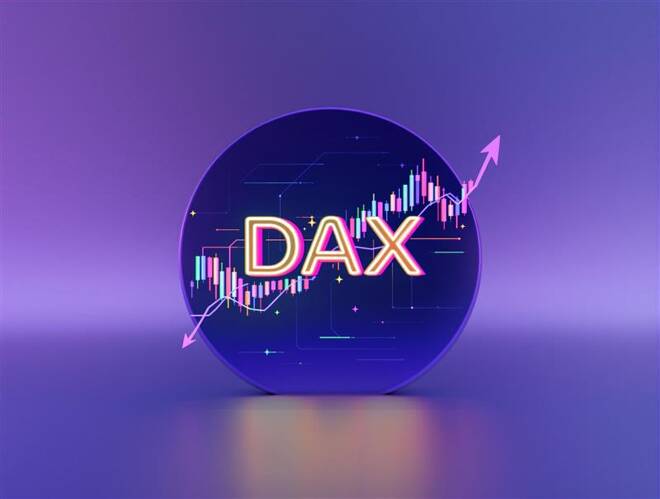Advertisement
Advertisement
Dax Index News: Trade Truce and Fed Bets Fuel DAX Rally – Forecast Signals Upside
By:
Key Points:
- DAX rose for the fourth session on May 13, closing at a record high of 23,639 on trade optimism and Fed policy hopes.
- Easing trade tensions and dovish central bank signals could push DAX toward the 23,912 resistance level.
- Technical outlook stays bullish as DAX holds above 50-day and 200-day EMAs with RSI at 67.9.
DAX Extends Winning Streak to Four Sessions on Trade and Fed Optimism
As the dust settled from news of a US-China trade war truce, favorable economic data lifted demand for German-listed stocks. The DAX rose for a fourth straight session on Tuesday, May 13, climbing 0.31% to a record close of 23,639.
Stock Movers: Autos Shine on Trade Developments
Germany’s auto sector led the charge amid rising hopes for a US-EU trade agreement. Volkswagen jumped 3.76% on March 13, with BMW gaining 3.02%. Mercedes-Benz Group and Porsche also posted solid gains.
Bayer advanced 2.83% after reporting better-than-expected earnings. In contrast, Munich Re Group and Hannover Re slid 4.55% and 4.44%, respectively, after reporting quarterly losses tied to the Los Angeles wildfires.
Investor Sentiment Rebounds in May
ZEW’s German Economic Sentiment Index surged from -14 in April to 25.2 in May, signaling a marked recovery in sentiment toward the German economy. The formation of a new government, easing tariff tensions, and steadying inflation boosted sentiment.
The prospect of further ECB rate cuts added support, with lower borrowing costs potentially lifting demand for German exports and corporate earnings.
Wall Street Mixed Despite Softer Inflation
US markets ended mixed on Tuesday, May 13. US economic data and corporate news contributed to market trends.
The Nasdaq Composite Index and the S&P 500 climbed 1.61% and 0.72%, respectively. Softer US inflation data fueled demand for rate-sensitive global stocks amid easing trade tensions. The annual inflation rate dropped to 2.3% in April, down from 2.4% in March, while core inflation remained at 2.8%. However, the data has yet to reflect the impact of tariffs on import prices and inflation.
In contrast, the Dow fell 0.64%, dragged down by corporate news. UnitedHealth tumbled 17.79% after the CEO stepped down and the firm suspended its annual forecast.
Fed Speakers in Focus
On Wednesday, May 14, the Fed reaction to April’s inflation figures and trade developments will influence global equities. Support for a June rate cut may drive demand for rate-sensitive stocks, while hawkish remarks may weigh on risk appetite.
Nevertheless, trade headlines remain a key driver for sentiment, particularly for the DAX.
DAX Outlook: Trade and Central Banks to Dictate Trends
The DAX’s outlook hinges on trade news, corporate earnings, and central bank guidance.
- Bullish Case: Easing trade tensions, solid earnings, and dovish central bank signals could send the DAX toward the May 12 high of 23,912.
- Bearish Case: Rising trade friction, weak earnings, or hawkish central bank rhetoric could send the DAX toward 23,500.
Frederik Ducrozet, Head of Macroeconomic Research at Pictet Wealth Management, remarked on ECB signals, stating:
“A very hawkish speech from Isabel Schnabel calling on the ECB ‘to keep a steady hand and maintain rates close to where they are today – that is, firmly in neutral territory’. Inflation risks tilted to the upside because of fiscal expansion and tariffs.”
As of Wednesday morning, the DAX futures were down 66 points, while the Nasdaq 100 mini climbed 7 points, suggesting a mixed start.
Technical Setup Suggests Cautious Optimism
With four straight gains, the DAX remains above the 50-day and the 200-day Exponential Moving Averages (EMA), indicating bullish momentum.
- Upside Target: A breakout above 23,750 would open the door to a move toward the record high of 23,912. A sustained move through 23,912 would bring 24,500 into sight.
- Downside risk: A drop below 23,500 may enable the bears to target 23,350, with 23,000 the next key support level.
The 14-day Relative Strength Index (RSI) at 67.90 shows the DAX has room to climb toward 23,912 before entering overbought territory (RSI > 70).
Conclusion: Monitor Macro Themes and Trade News
DAX traders should continue tracking trade headlines, central bank guidance, and earnings reports for direction.
Explore our exclusive forecasts to see whether trade optimism can extend the DAX’s winning streak. Click here to explore our latest DAX research, macro insights, and emerging market coverage.
About the Author
Bob Masonauthor
With over 28 years of experience in the financial industry, Bob has worked with various global rating agencies and multinational banks. Currently he is covering currencies, commodities, alternative asset classes and global equities, focusing mostly on European and Asian markets.
Advertisement
